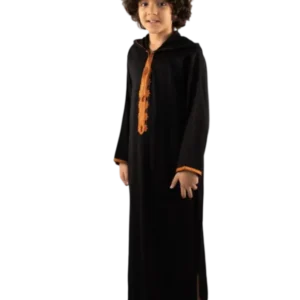
Discovering the Timeless Elegance of the Djellaba: Moroccan Women’s Fashion
In the tapestry of global fashion, few garments possess the rich history, cultural significance, and enduring elegance of the Moroccan djellaba. Originating from North Africa, particularly Morocco, the djellaba is a traditional robe worn by both men and women, but it holds a special place in the wardrobe of Moroccan women. With its graceful silhouette, intricate details, and vibrant colors, the djellaba is not just a piece of clothing but a symbol of Moroccan identity, heritage, and beauty.
Origins and Evolution
The origins of the djellaba can be traced back centuries, where it was originally worn as a protective garment against the harsh desert climate. Over time, it evolved from a practical necessity to a sartorial symbol of elegance and cultural pride. Today, the djellaba continues to be an integral part of Moroccan fashion, cherished for its timeless appeal and versatility.
Design and Aesthetic
One of the most striking features of the djellaba is its flowing silhouette, which drapes gracefully over the wearer’s body, exuding an air of effortless sophistication. Traditionally made from high-quality fabrics such as wool, silk, or cotton, the djellaba is often embellished with intricate embroidery, delicate beading, or colorful tassels, showcasing the artistry and craftsmanship of Moroccan artisans.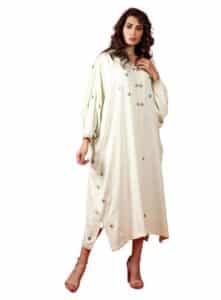
Versatility and Adaptability
What makes the djellaba truly remarkable is its versatility. While rooted in tradition, it has seamlessly adapted to modern times, serving as both everyday attire and formal wear. Moroccan women often wear the djellaba as a practical outer layer, providing warmth and protection against the elements, especially in the cooler months. However, it is also commonly worn on special occasions, such as weddings, festivals, and religious celebrations, where it takes on a more ornate and ceremonial character.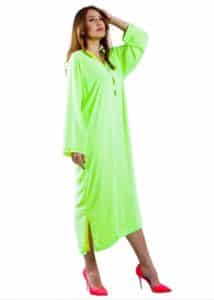
Cultural Significance
Beyond its aesthetic appeal, the djellaba holds deep cultural significance in Moroccan society. It is not simply a piece of clothing but a symbol of identity, tradition, and heritage. For many Moroccan women, wearing the djellaba is a way to connect with their roots, celebrate their cultural heritage, and express their sense of belonging to the rich tapestry of Moroccan society.
Embracing Tradition in a Modern World
In an era of rapid globalization and homogenization of fashion, the djellaba stands as a testament to the enduring power of tradition and craftsmanship. While contemporary fashion trends come and go, the timeless elegance of the djellaba remains unchanged, captivating the hearts of fashion enthusiasts around the world.
Conclusion
In the kaleidoscope of global fashion, the Moroccan djellaba shines brightly as a beacon of timeless elegance, cultural pride, and sartorial sophistication. Worn by generations of Moroccan women, it continues to inspire awe and admiration, serving as a symbol of the rich heritage and enduring beauty of Moroccan fashion.
Whether donned as a practical garment for everyday wear or as a ceremonial attire for special occasions, the djellaba embodies the essence of Moroccan identity and tradition, weaving together the threads of past and present in a tapestry of timeless elegance
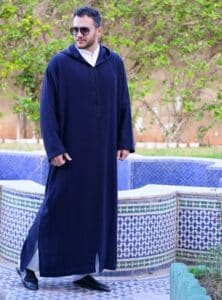 In the realm of Moroccan fashion, few garments command the same reverence and admiration as the djellaba. Rooted in centuries of tradition and imbued with cultural significance, the djellaba for men is not just a piece of clothing but a symbol of elegance, heritage, and identity. Let’s delve into the timeless allure of the Moroccan djellaba and its enduring relevance in contemporary men’s fashion.
In the realm of Moroccan fashion, few garments command the same reverence and admiration as the djellaba. Rooted in centuries of tradition and imbued with cultural significance, the djellaba for men is not just a piece of clothing but a symbol of elegance, heritage, and identity. Let’s delve into the timeless allure of the Moroccan djellaba and its enduring relevance in contemporary men’s fashion.
Origins and Heritage
The history of the djellaba traces back to the ancient civilizations of North Africa, where it served as a practical garment for protection against the harsh desert climate. Over time, it evolved into a distinctive robe that became synonymous with Moroccan culture and tradition. Made from luxurious fabrics such as wool or cotton, and often adorned with intricate embroidery or decorative trimmings, the djellaba reflects the artistry and craftsmanship of Moroccan artisans.
Design and Craftsmanship
One of the defining features of the djellaba is its elegant silhouette, characterized by its loose, flowing shape and hooded design. The simplicity of its construction belies the complexity of its craftsmanship, with meticulous attention to detail evident in every stitch and embellishment. From the skillful embroidery to the intricate patterns woven into the fabric, each djellaba is a masterpiece of Moroccan craftsmanship, showcasing the country’s rich textile heritage.
Versatility and Adaptability
Despite its traditional roots, the djellaba has adapted remarkably well to the modern world, seamlessly transitioning from a practical garment to a versatile fashion statement. Moroccan men often wear the djellaba as everyday attire, especially during religious or cultural gatherings, where it provides both comfort and style. However, it is also a popular choice for formal occasions, such as weddings or festivities, where it exudes an air of regal elegance and sophistication.
Cultural Significance
Beyond its aesthetic appeal, the djellaba holds deep cultural significance in Moroccan society, symbolizing masculinity, tradition, and pride. For many Moroccan men, wearing the djellaba is not just a fashion choice but a reflection of their cultural identity and heritage. It serves as a tangible link to the past, connecting them to their ancestors and the rich tapestry of Moroccan history.
Embracing Tradition in a Modern World
In an age of rapid globalization and changing fashion trends, the djellaba stands as a timeless testament to the enduring power of tradition and craftsmanship. While contemporary styles may come and go, the timeless elegance of the djellaba remains unchanged, captivating the hearts of fashion connoisseurs around the world.
Conclusion
In the ever-evolving landscape of men’s fashion, the Moroccan djellaba stands out as a symbol of timeless elegance, cultural pride, and sartorial sophistication. Worn by generations of Moroccan men, it continues to inspire awe and admiration, serving as a reminder of the rich heritage and enduring beauty of Moroccan fashion.
Whether worn as a practical garment for everyday wear or as a ceremonial attire for special occasions, the djellaba embodies the essence of Moroccan masculinity, weaving together tradition and modernity in a seamless fusion of style and sophistication.
 In the vibrant tapestry of Moroccan fashion, the djellaba holds a special place not just for adults but also for children. With its enchanting designs, vibrant colors, and cultural significance, the djellaba for children embodies the timeless elegance and charm of Moroccan tradition.
In the vibrant tapestry of Moroccan fashion, the djellaba holds a special place not just for adults but also for children. With its enchanting designs, vibrant colors, and cultural significance, the djellaba for children embodies the timeless elegance and charm of Moroccan tradition.
Crafted with care and attention to detail, children’s djellabas capture the essence of Moroccan craftsmanship and heritage. Made from soft, breathable fabrics, they are designed to provide comfort and ease of movement for young wearers while still exuding an air of sophistication and style.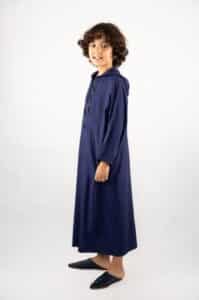
Adorned with playful embellishments such as colorful embroidery, delicate trims, and whimsical tassels, children’s djellabas add a touch of whimsy and joy to any occasion. Whether worn for everyday adventures or special celebrations, they are sure to delight both children and parents alike.
Beyond their aesthetic appeal, children’s djellabas also carry deep cultural significance, serving as a symbol of Moroccan identity and tradition. By dressing their children in djellabas, Moroccan parents pass down cherished customs and values from generation to generation, instilling a sense of pride and belonging in their heritage.
In a world dominated by fast fashion and fleeting trends,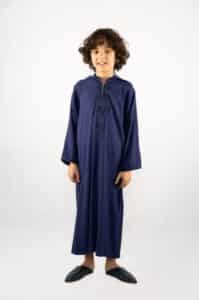 children’s djellabas stand out as timeless treasures, celebrating the rich cultural heritage and enduring beauty of Moroccan fashion. With their timeless elegance and undeniable charm, they remind us of the importance of preserving tradition and embracing the magic of childhood in all its colorful splendor.
children’s djellabas stand out as timeless treasures, celebrating the rich cultural heritage and enduring beauty of Moroccan fashion. With their timeless elegance and undeniable charm, they remind us of the importance of preserving tradition and embracing the magic of childhood in all its colorful splendor.

